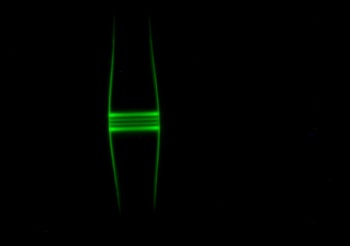
The light in a glass fiber is coupled to a bottle resonator. Image Credit: TU Wien
Researchers at the Vienna University of Technology (TU Wien) have successfully developed a system, using an ultra-thin glass fibre, which allows two photons to strongly interact with each other.
Generally, in free space two photons do not interact. However, photon-photon interactions are very important within the field of quantum optics for the construction of optical logic gates and to create quantum information networks which enable the secure transmission of data.
Until now, non-linear media has been used in order to make light to interact with light. In this method light affects the material’s properties and the material has an influence on the light.
This process causes indirect photon coupling. However, the main drawback of using this method is that strong light intensities are needed and many photons take part in the process.
 Light runs around a bottle-shaped glass fiber, about half as thick as a human hair. Image Credit: TU Wien
Light runs around a bottle-shaped glass fiber, about half as thick as a human hair. Image Credit: TU Wien
In the system built at TU Wien, the interaction takes place only between two photons, and the strength of the interaction causes the photons to change phase by 180°. The researchers used a minimal amount of light to achieve the highest interaction. They coupled a very thin glass fibre to a small bottle-like light resonator.
This made the light to enter the resonator partly, then move in circles and then come back to the glass fibre. This caused inversion of the phase of the photon. The researchers then coupled a single rubidium atom to the resonator. This prevented light from entering the resonator and the photon’s oscillation phase could not be changed.
However, when two photons arrive simultaneously, a different phenomenon occurs. The atom absorbs a photon for a short period and then releases it into the resonator. As it absorbs only one photon, the other photon gets phase shifted.
These photons cannot be distinguished from each other. This method enables creation of a photon state with maximum entanglement, which would be useful in quantum optics, quantum teleportation and quantum computing. The researchers have published this study in Nature Photonics journal.
This News Feature Around the Web